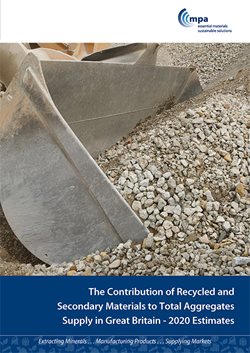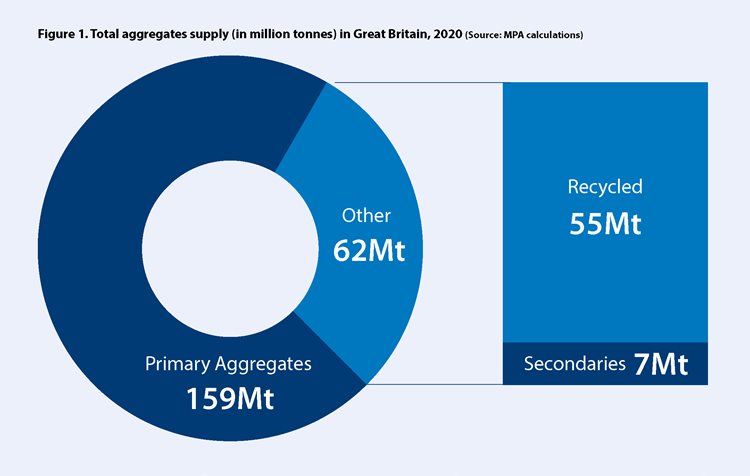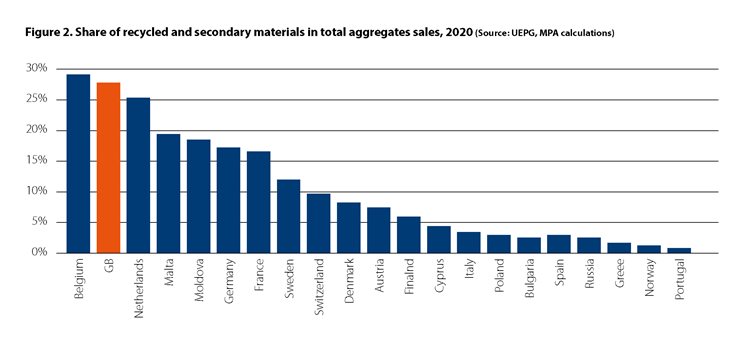 Britain’s biggest recycling success story is approaching maximum capacity with the vast majority of reusable materials being put back into use in construction.
Britain’s biggest recycling success story is approaching maximum capacity with the vast majority of reusable materials being put back into use in construction.
The Mineral Products Association (MPA) says recovery of construction waste to produce recycled aggregates – and processing of industrial by-products into secondary aggregates – is close to reaching its upper limit.
In a new report based on data from 2020, MPA estimates that 28% of aggregates for construction come from recycled and secondary sources – some 62 million tonnes in 2020. That means the mineral products industry recycles more than any other sector by volume and places Britain among the leading recyclers of construction materials in Europe.
Recycled aggregates, around 55 million tonnes of which were produced in 2020, come from Construction, Demolition & Excavation Wastes (CDEW) such as crushed concrete and brick, old rail ballast and material from groundworks. Secondary aggregates, which accounted for the remaining 7 million tonnes in 2020, are derived from industrial or extractive processes including the production of china clay, slate and chalk, plus glass reprocessing, mining spoil, incinerator ash, and slag from iron and steel production.
The MPA report also highlights that newly-quarried primary materials – virtually all of which come from UK sources – are still needed to meet the remaining 72% of the total aggregate demand from the construction sector. Even in years when the need for aggregates falls due to a reduction in construction activity, the volume of materials available for recycling also drops proportionally because there’s less demolition to give rise to source material.
Nigel Jackson, MPA Chief Executive, said: “Recycled and secondary aggregates is an outstanding circular economy story that supports and delivers the UK Waste Strategy, yet is barely recognised by the Government. When MPA members prepare for a planning application to extract new minerals for the construction industry, they are often faced with the argument that they should be recycling more. The fact is that aggregates producers are already recycling the available materials, and have been for many years, to meet the demand as efficiently and sustainably as possible. It’s therefore important to stress that primary aggregates are still needed to meet around 70% of demand from construction and that situation will continue for the long term.”
Because of the lack of readily available information on recycling of construction materials, to analyse the data the MPA has developed a methodology to track the contribution of recycled and secondary aggregates to overall aggregates supply. The system is based on published statistics from MPA members and other third parties, combined with a number of tried and tested assumptions.
Aurelie Delannoy, MPA Director of Economic Affairs who authored the report said: “The growing policy focus on the circular economy contrasts with the absence of regular data monitoring on the use of recycled and secondary aggregates, both at national and regional scale. MPA has developed a methodology to track the contribution of these materials to overall aggregates supply with the aim to fill this gap.”
While many industries are still grappling with the challenges of implementing an effective circular economic model, heavy-side materials producers have become adept at making efficient use of available resources – companies are working to produce recycled and secondary aggregates that meet stringent requirements for use across different construction sectors.
Any materials that cannot be turned into suitable construction aggregate are used in land remediation and quarry restoration schemes which are widely recognised as uniquely supporting nature recovery and biodiversity net gain (as showcased last year by the MPA in ‘Quarries & Nature… a 50 year success story’).
The new MPA recycling report The Contribution of Recycled and Secondary Materials to Total Aggregates Supply in Great Britain can be viewed on the MPA website.
Ends.
Note to Editors:


About the Mineral Products Association:
The Mineral Products Association (MPA) is the trade association for the aggregates, asphalt, cement, concrete, dimension stone, lime, mortar and silica sand industries. With the merger of British Precast, and affiliation of the British Association of Reinforcement (BAR), Eurobitume, MPA Northern Ireland, MPA Scotland and the British Calcium Carbonate Federation, it has a growing membership of 520 companies and is the sectoral voice for mineral products. MPA membership is made up of the vast majority of independent SME quarrying companies throughout the UK, as well as the 9 major international and global companies. It covers 100% of UK cement and lime production, 90% of GB aggregates production, 95% of asphalt and over 70% of ready-mixed concrete and precast concrete production. In 2018, the industry supplied £16 billion worth of materials and services to the Economy. It is also the largest supplier to the construction industry, which had annual output valued at £172 billion in 2018. Industry production represents the largest materials flow in the UK economy and is also one of the country’s largest manufacturing sectors.
For media enquiries, contact Elizabeth Clements at: Elizabeth.Clements@mineralproducts.org.